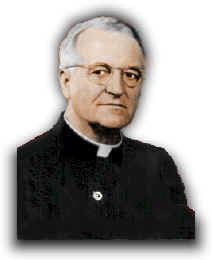Name Leonard Feeney Role Priest | ||
 | ||
Occupation priestpoetlyricisteditortheologianchaplain Books In towns and little towns, The Leonard Feeney omnibus Education Harvard University, University of Oxford | ||
Fr. Leonard Feeney and Feeneyism - The Whole Truth about Fr. Leonard Feeney, Feeneyism, Feeneyites
Father Leonard Edward Feeney (February 18, 1897 – January 30, 1978) was a U.S. Jesuit priest, poet, lyricist, and essayist.
Contents
- Fr Leonard Feeney and Feeneyism The Whole Truth about Fr Leonard Feeney Feeneyism Feeneyites
- Bishop Kelly talks about Fr Leonard Feeney
- Biography
- The Point
- References
He articulated and defended a strict interpretation of the Roman Catholic doctrine, extra Ecclesiam nulla salus ("outside the Church there is no salvation"). He took the position that baptism of blood and baptism of desire are unavailing and that therefore no non-Catholics will be saved. Fighting against what he perceived to be the liberalization of Catholic doctrine, he came under ecclesiastical censure. He was described as Boston's homegrown version of Father Charles Coughlin for his antisemitism.
Bishop Kelly talks about Fr. Leonard Feeney
Biography
Feeney was born in Lynn, Massachusetts, on February 18, 1897.
He entered the novitiate in 1914 and was ordained a priest in 1928.
In the 1930s, he was literary editor at the Jesuit magazine, America.
He was a professor in Boston College's graduate school, and then professor of spiritual eloquence at the Jesuit seminary in Weston, Massachusetts, before he became the priest chaplain at the Catholic Saint Benedict Center at Harvard Square in 1945. (He had first visited in 1941.) He gave incendiary speeches on the Boston Common on Sundays, leading Robert Kennedy, then a Harvard undergraduate, to write Archbishop Cushing of Boston requesting his removal. He induced some of the faithful to drop out of Harvard or Radcliffe to become students at his Center, now accredited as a Catholic school. From 1946, the Center published From the Housetops, a periodical focused on Catholic theology that enjoyed contributions from the archbishop himself. By 1949, it had begun a controversy over extra ecclesiam nulla salus that led to four of the Center's members' dismissal from their posts in the Boston College theology faculty and Boston College High School.
In light of his controversial behavior, his Jesuit superiors ordered him to leave the Center for a post at College of the Holy Cross, but he repeatedly refused.
On August 8, 1949, Cardinal Francesco Marchetti Selvaggiani of the Holy Office sent a protocol letter to Archbishop Cushing on the meaning of the dogma extra Ecclesiam nulla salus (outside the church there is no salvation), which Feeney refused to accept. This protocol was never published in the Acta Apostolicae Sedis. After Feeney repeatedly refused to reply to this summons to Rome, he was excommunicated on February 13, 1953 by the Holy See for persistent disobedience to legitimate Church authority due to his refusal to comply with the summons. The decree of excommunication was later published in the Acta Apostolicae Sedis. His followers said that his excommunication was invalid because Feeney was not given a reason for his summons.
Following his excommunication, Feeney set up a community called the Slaves of the Immaculate Heart of Mary. He was reconciled to the Roman Catholic Church in 1972, but was not required to retract or recant his interpretation of "Extra Ecclesiam Nulla Salus". The phrase is inscribed on his tombstone.
Speaking two decades after the controversy Cardinal Avery Dulles judged Feeney's doctrine on a series of lectures not having to do with "extra Ecclesiam..." to be quite sound. Dulles' reflections on Feeney's life did not endorse nor deny Feeney's views on extra Ecclesiam nulla salus, and spoke only to his theology, not his political views on issues such as Zionism.
Feeney died in Ayer, Massachusetts, on January 30, 1978. He received a Mass of Christian Burial by his bishop.
The Point
Feeney was editor of "The Point," which ran a mixture of theological and political articles, many of them branded anti-semitic by Feeney's critics. The newsletter frequently contained sentiments such as:
... the Church has never abandoned her absolute principle that it is possible for an individual Jew to scrap his hateful heritage, sincerely break with the synagogue, and cleanse his cursed blood with the Precious Blood of Jesus. (October 1957)
... we spoke about the plague of Marrano (secret-Jew) Catholics in Spain, and the extreme means (the Inquisition) which was necessary to keep their influence from spreading. (October 1957)
Those two powers, the chief two in the world today, are Communism and Zionism. That both movements are avowedly anti-Christian, and that both are in origin and direction Jewish, is a matter of record. (September 1958)
As surely and securely as the Jews have been behind Freemasonry, or Secularism, or Communism, they are behind the "anti-hate" drive. The Jews are advocating tolerance only for its destructive value — destructive, that is, of the Catholic Church. On their part, they still keep alive their racial rancors and antipathies." (July 1955)
A single year, 1957, saw the following article titles:
January: "Jewish Invasion of Our Country—Our Culture Under Siege"February: "When Everyone Was Catholic—The Courage of the Faith in the Thirteenth Century"March: "Dublin's Briscoe Comes to Boston"April: "The Fight for the Holy City—Efforts of the Jews to Control Jerusalem"May: "Our Lady of Fatima Warned Us"June: "The Rejected People of Holy Scripture: Why the Jews Fear the Bible"July: "The Judaising of Christians by Jews—Tactics of the Church's Leading Enemies"August: "A Sure Defence Against the Jews—What Our Catholic Bishops Can Do for Us"September: "An Unholy People in the Holy Land—The Actions of the Jews"October: "The Jewish Lie About Brotherhood—the Catholic Answer—Israeli Brotherhood"November: "Six Pointers on the Jews"